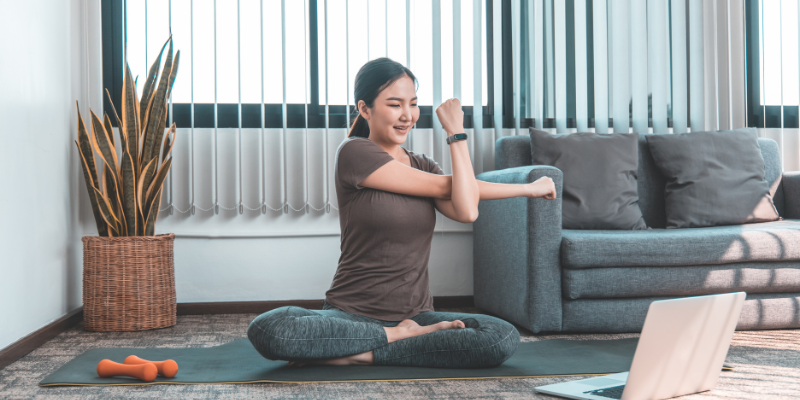7 Ways to Incorporate Exercise into Your Daily Routine

Regular exercise is crucial for maintaining good physical and mental health. However, with our busy schedules and hectic lifestyles, it can be challenging to find time for exercise. But, incorporating exercise into your daily routine is essential to staying healthy and active. In this article, we will explore seven ways to incorporate exercise into your daily routine, regardless of how busy you are.
Why Should You Incorporate Exercise into Your Daily Routine?
Incorporating exercise into your daily routine is crucial for maintaining good physical and mental health. Regular exercise helps to strengthen your muscles, bones, and cardiovascular system, reducing the risk of chronic diseases such as obesity, type 2 diabetes, and heart disease. Exercise also helps to improve your mood and reduce stress and anxiety by releasing endorphins and reducing cortisol levels in the body.
Additionally, incorporating exercise into your daily routine can improve your overall energy levels and productivity, making you feel more alert and focused throughout the day. By taking the time to prioritize exercise as a part of your daily routine, you are investing in your long-term health and well-being. It will help you to live healthier today.
Set Realistic Goals
Setting realistic goals is a crucial step in incorporating exercise into your daily routine. Here are some bullet points to keep in mind when setting your goals:
- Start small: don’t try to do too much too soon. Set achievable goals that you can build upon as your fitness level improves.
- Be specific: set clear, measurable goals, such as running a certain distance or lifting a certain weight.
- Make it meaningful: focus on why you want to exercise and how it will benefit you. This can help to keep you motivated and committed to your goals.
- Set a timeline: give yourself a deadline to achieve your goals. This can help to keep you on track and focused on your progress.
- Celebrate your achievements: when you reach your goals, take the time to celebrate and acknowledge your hard work. This can help to build confidence and motivation for future goals.
By setting realistic goals, you can establish a regular exercise routine that is both challenging and achievable. Remember to be patient and persistent, and don’t be discouraged by setbacks. With dedication and a positive mindset, you can make exercise a regular and rewarding part of your daily routine.
Wake up Early and Exercise
Waking up early and exercising is a great way to start your day on the right foot. Here are some reasons why you should consider making this a regular part of your routine:
- Increased energy and productivity: exercise releases endorphins that boost your mood and energy levels, helping you to feel more awake and focused throughout the day.
- Improved sleep: by waking up earlier and exercising in the morning, you can help regulate your body’s natural sleep-wake cycle, leading to better sleep at night.
- Fewer distractions: early mornings are typically quieter and less busy, providing a calm and distraction-free environment for your workout.
- Better consistency: by getting your exercise done in the morning, you eliminate the risk of other events or responsibilities interfering with your workout later in the day.
- Greater sense of accomplishment: completing a morning workout before most people even wake up can give you a sense of achievement and motivation to tackle the rest of your day.
If you’re not a morning person, it may take some time to adjust to waking up earlier. However, once you establish a routine, you’ll likely find that the benefits of morning exercise far outweigh the initial discomfort of waking up earlier. Consider setting your alarm a little earlier and incorporating a morning workout into your daily routine to experience these benefits for yourself.
Take the Stairs
Taking the stairs is a simple but effective way to incorporate more physical activity into your daily routine. Here are some reasons why you should consider ditching the elevator and taking the stairs instead:
- Increased physical activity: taking the stairs requires more effort than riding an elevator, providing a quick and easy way to add more physical activity to your day.
- Improved cardiovascular health: stair climbing is a form of aerobic exercise, which can help to improve your cardiovascular health over time.
- Stronger muscles: climbing stairs engages the muscles in your legs, hips, and glutes, helping to strengthen and tone these areas.
- More calorie burn: climbing stairs burns more calories than riding an elevator, making it a great way to supplement your weight loss or fitness goals.
- Faster commute: depending on the building and time of day, taking the stairs may actually be faster than waiting for and riding an elevator.
By incorporating stair climbing into your daily routine, you can add a quick and easy burst of physical activity to your day. Whether you’re at work, running errands, or just going about your daily life, taking the stairs is a simple but effective way to improve your health and fitness.
Exercise During Lunch Breaks
Many of us lead busy lives, juggling work, family, and other commitments, leaving little time for physical activity. However, by taking advantage of your lunch break, you can easily incorporate exercise into your daily routine. Here are some reasons why you should consider exercising during your lunch break:
- Increased productivity: exercise has been shown to boost mood, energy levels, and cognitive function, helping you to be more productive and focused throughout the day.
- Convenient and time-saving: by exercising during your lunch break, you can save time and eliminate the need to squeeze in a workout before or after work.
- Social and team-building: if you have colleagues who are also interested in exercise, lunchtime workouts can be a great way to bond and build camaraderie with your coworkers.
- Improved physical health: regular exercise can help to reduce the risk of chronic diseases, such as obesity, diabetes, and heart disease, among others.
- Better mental health: exercise has been shown to have a positive impact on mental health, reducing stress and anxiety and improving overall well-being.
If you’re interested in incorporating exercise into your lunch break, consider packing a gym bag or workout clothes to bring with you to work. You can also research nearby gyms or fitness classes in your area. Even a brisk walk around your office building or a set of bodyweight exercises in a quiet corner can make a big difference in your health and well-being. Don’t let a busy schedule get in the way of your fitness goals – use your lunch break to your advantage and prioritize your health and well-being.
Make Your Commute Active

For many people, commuting to and from work is a daily ritual that can take up a significant amount of time. However, instead of sitting in traffic or on public transportation, why not make your commute more active? Here are some reasons why you should consider incorporating physical activity into your commute:
- Increased physical activity: walking, biking, or running to work can be a great way to increase your daily physical activity, helping you to stay active and healthy.
- Improved mental health: exercise has been shown to have a positive impact on mental health, reducing stress and anxiety and improving overall well-being.
- Save money: by walking or biking to work, you can save money on gas or public transportation costs, while also reducing your carbon footprint.
- Time-saving: depending on the distance and traffic in your area, active commuting can actually be faster than driving or taking public transportation, helping you to save time in your day.
- Enjoyment: many people find that active commuting is a fun and enjoyable way to start and end their workday, providing a sense of accomplishment and boosting their mood.
If you’re interested in making your commute more active, consider walking or biking to work if feasible. You can also try getting off public transportation a few stops early and walking the rest of the way, or parking further away from your workplace and walking the remaining distance. By incorporating physical activity into your daily commute, you can improve your health and well-being, while also saving money and time.
Exercise While Watching TV
For many people, watching TV is a daily activity that can take up a significant amount of time. However, instead of just sitting on the couch, why not make TV time more active? Here are some reasons why you should consider exercising while watching TV:
- Increased physical activity: exercising while watching TV can be a great way to increase your daily physical activity, helping you to stay active and healthy.
- Improved mental health: exercise has been shown to have a positive impact on mental health, reducing stress and anxiety and improving overall well-being.
- Time-saving: by combining TV time with exercise, you can save time in your day, allowing you to multitask and accomplish more.
- Enjoyment: many people find that exercising while watching TV is a fun and enjoyable way to stay active, providing a sense of accomplishment and boosting their mood.
If you’re interested in exercising while watching TV, consider doing bodyweight exercises such as squats, lunges, or push-ups during commercial breaks. You can also try using resistance bands or weights while watching your favorite show. By incorporating physical activity into your TV time, you can improve your health and well-being, while also enjoying your favorite shows. So, next time you settle in to watch TV, grab your resistance band or weights and get ready to exercise!
Frequently Asked Questions
Q: What is the best time to exercise?
A: The best time to exercise is whenever it works for you. Some people prefer to exercise in the morning, while others prefer to exercise in the evening.
Q: How much exercise do I need each day?
A: The American Heart Association recommends at least 150 minutes of moderate-intensity exercise per week.
Q: Can I exercise at home without any equipment?
A: Yes, there are plenty of exercises you can do at home without any equipment, such as push-ups, squats, lunges, and yoga poses.
Q: How can I stay motivated to exercise?
A: Set realistic goals, track your progress, find an exercise buddy, and reward yourself for your achievements.
Q: Can exercise help to reduce stress and anxiety?
A: Yes, exercise is a great way to reduce stress and anxiety. It releases endorphins, which are natural mood boosters, and helps to reduce cortisol levels in the body.
7 Ways to Incorporate Exercise into Your Daily Routine: Final Thoughts
Incorporating exercise into your daily routine is essential for maintaining good health and well-being. By setting realistic goals, waking up early, taking the stairs, exercising during lunch breaks, making your commute active, and exercising while watching TV, you can easily incorporate exercise into your daily routine. Remember to start small, be consistent, and gradually increase the intensity and duration of your exercise routine. With these tips, you can stay fit and healthy, even with a busy lifestyle. For more information check out this article on 30 minute at home workouts.


